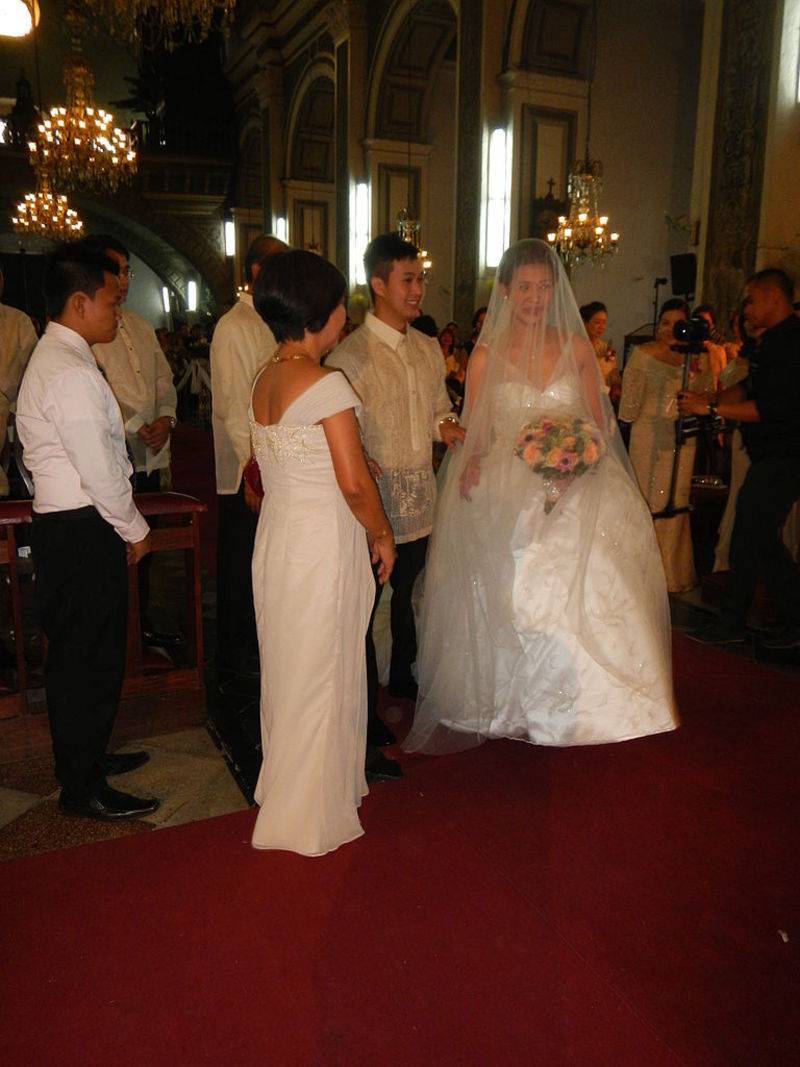Philippine Wedding
Philippine weddings, known as "kasalan," blend local traditions with influences from Spanish and American rule. Key customs include the groom seeking the bride's parents' approval ("pamanhikan"), a Catholic ceremony with significant roles for godparents, and symbolic acts like the exchange of 13 coins and the lighting of a unity candle. Modern weddings often feature a "money dance," the release of white doves for harmony, and a reception filled with dancing and traditional gift-giving practices.
Philippine Wedding
A traditional Philippine wedding ("kasalan") represents a combination of local traditions, religion and influences as result of time spend under rule of Spain and the USA.
In the Philippines a relationship starts with courting ("panliligaw"). Then the couple gets engaged ("kasunduan"). There is also a tradition where a groom-to-be has to ask bride-to-be's parents to approve his wish to marry their daughter. This is known as the "pamanhikan" or "pamamanhikan". After they say "yes" all the wedding related details are arranged.
The "pa-alam" is the next in the line of Philippine wedding traditions. The couple visits their cousins and tells them that they are going to marry. Formal wedding invitations are also given then.
The most popular time for weddings is June. Some people believe that a waxing moon on a wedding day means good luck. Rain has a similar positive effect for the couple's future. If either bride or groom has brothers or sisters they should not marry in the same year. It is considered bad luck.

Philippine brides nowadays wear white western style wedding dresses. They carry a bridal flower bouquet and a rosary. Brides in more traditional communities are dressed in white "baro't saya".
Philippine grooms still keep to the local tradition. They wear the "barong tagalog" shirt and black trousers.
Most Filipinos are Roman Catholics. So wedding ceremony is the Catholic one. A groom and sometimes his parents welcome the guests. So he arrives earlier than a bride. She and her parents arrive in a wedding car.
Godparents or wedding sponsors like they are also known play a very important part in every wedding. Traditionally there are three pairs of godmothers ("ninang") and godfathers ("ninong"). They perform several duties during the wedding ceremony.
In every wedding ceremony there is a person who carries wedding rings. After an exchange of rings between a bride and a groom there is another act. A groom gives his bride the 13 golden or silver coins ("arras").
These coins symbolically show the groom's devotion to ensure financial security for the bride and their future children.
Usually there are two candles lit. One is next to the bride and another one next to the groom. They represent the symbol of God's presence in the wedding ceremony. Sometimes the couple will use already mentioned candles to light the third candle. This so called unity candle. It represents the newly formed union between two families.
What follows next is the pinning of a single veil or two of them on the bride and groom. It is done by a couple of godparents.
There is more. The next two godparents will put the wedding cord ("yugal") over the couple's shoulders. The cord is put in the shape of "8". It is done so as the Filipinos think that it is the lucky number. The cord is a symbol of fidelity.
Before leaving the church the bride puts her flower bouquet at the altar dedicated to the Virgin Mary or some Saint. The couple also signs a wedding contract.
As everywhere there is lot of dancing at the wedding reception. The first dance is by the bride and groom. Luzon is the largest island in the Philippines. Local weddings include so called "money dance" where dancers pin banknotes on the bride's and groom's clothes.
The couple traditionally release a pair of white doves. They represent the bliss and harmony.
A wedding cake is cut by the couple. They then feed each other with it. Many toasts are made. A small present is given to female guests or sometimes to all guests.
As to the wedding gifts one should avoid giving knives as there is a belief according to which this may result in a bad marriage. On other side chamber pots are still by some regarded as a good wedding gift.
References
Marriage and wedding customs in the Philippines
http://en.wikipedia.org/wiki/Marriage_and_wedding_customs_in_the_Philippines
Philippine Wedding Traditions
http://en.wikipilipinas.org/index.php/Philippine_Wedding_Traditions
Filipino Wedding Traditions
http://weddingsinthephilippines.com/filipino-wedding-traditions/
Wedding Day Festivities and Ceremonies
http://www.kasal.com/html/philippine-wedding/wedding-custom/wedding-day-festivities-and-ceremonies.html
Philippine Wedding Customs and Superstitions
http://www.asian-recipe.com/philippines/ph-information/philippine-wedding-customs-and-superstitions.html
Marriage and Wedding customs in the Philippines
http://philippinemarandwed.blogspot.com/
Image(s)
Philippine Wedding (photo by Judgefloro)
http://commons.wikimedia.org/wiki/File:FvfIntramurosChurch2759_08.JPG
Creative Commons: File:Malapascua Island, Sunset on the beach with palms, Philippines.jpg
File:Chiang-Mai Thailand Buddhist-Manuscript-Library-and-Museum-01.jpg